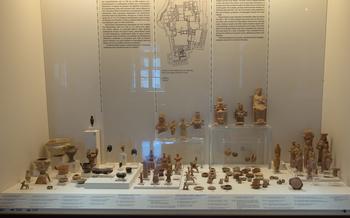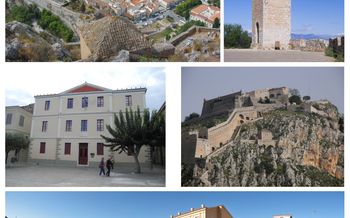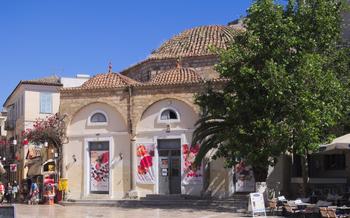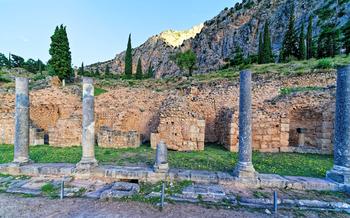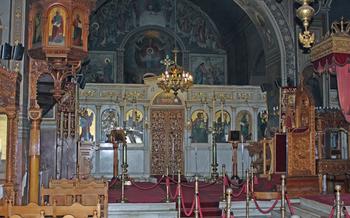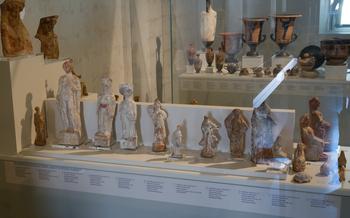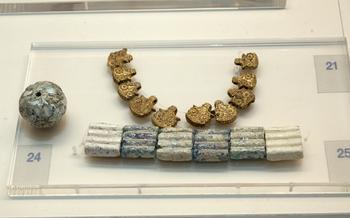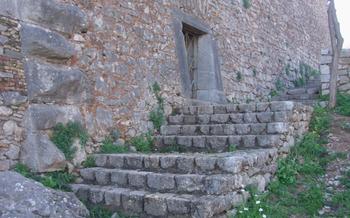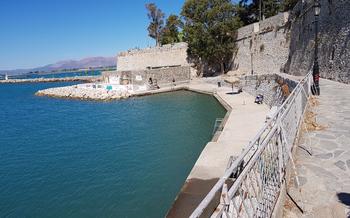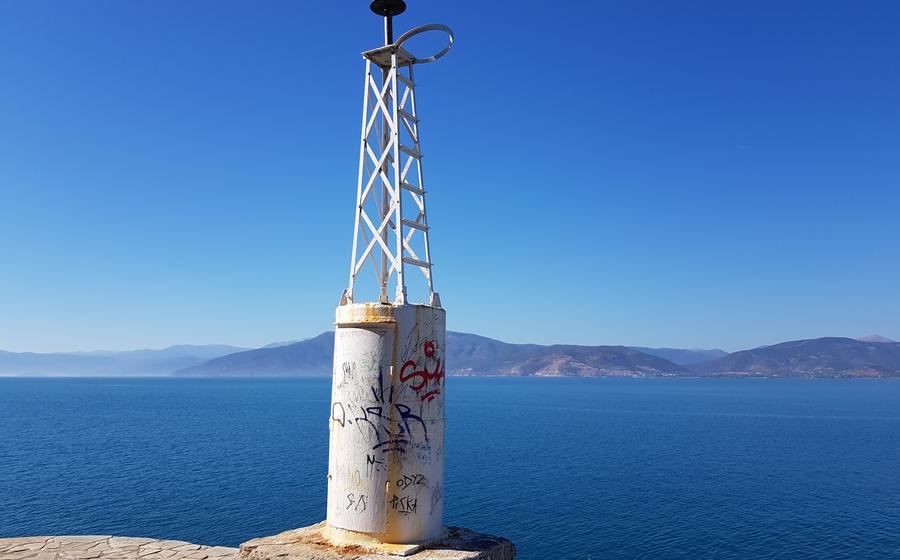
Ancient Corinth
- Nafplio: A Journey to the Heart of Greece's Ancient Past
- Ancient Corinth: A Tale of Two Cities
- The Acrocorinth: A Majestic Citadel
- The Ancient Theater of Corinth: A Stage for Drama and Spectacle
- The Temple of Apollo: A Symbol of Divine Worship
- The Market: A Bustling Center of Trade
- The Bema: A Seat of Justice and Eloquence
- The Corinth Canal: A Marvel of Engineering
- The Archaeological Museum of Corinth: A Treasure Trove of Ancient Artifacts
- The Sanctuary of Asklepios: A Healing Sanctuary
- The Loutraki Thermal Baths: A Soothing Retreat
- The Venetian Castle of Palamidi: A Majestic Fortress
- The Bourtzi Castle: A Symbol of Strength and Resilience
- The Museum of the Peloponnesian Folklore: A Cultural Journey
Nafplio: A Journey to the Heart of Greece's Ancient Past
Nafplio, a captivating city nestled in the Peloponnese peninsula of Greece, unveils a rich tapestry of history, culture, and natural beauty. As the first capital of modern Greece, Nafplio holds a significant place in the nation's history. Its strategic location at the crossroads of the Peloponnese and the Saronic Gulf has shaped its destiny, leaving an indelible mark on the course of Greek history.
Strolling through the picturesque streets of Nafplio, visitors are greeted by a harmonious blend of Venetian, Ottoman, and Greek architecture. The city's charm lies in its unique fusion of cultural influences, creating a vibrant atmosphere that captivates the senses. Explore the bustling harbor, where fishing boats bob gently on the waves, and the aroma of fresh seafood fills the air. Discover charming cafes, inviting tavernas, and lively shops that line the narrow streets, creating a vibrant energy that pulses through the city.
Ancient Corinth: A Tale of Two Cities
Ancient Corinth, a prominent city in the Roman province of Achaea, boasts a fascinating history that spans millennia. Its strategic location at the crossroads of major trade routes made it a prosperous and influential city-state. Visitors can explore the impressive archaeological ruins of Ancient Corinth, including the Temple of Apollo, the Market, and the Bema, which offer a glimpse into the city's rich past.
The city's history is intertwined with the Apostle Paul, who spent a significant amount of time in Corinth and wrote influential letters to the Corinthians. His presence left an enduring legacy, shaping the city's religious and cultural identity.
Ancient Corinth also played a crucial role in the development of Western architecture, particularly through the introduction of the Corinthian order, an ornate and elaborate style of column that became a hallmark of Roman and later Western architecture.
The Acrocorinth: A Majestic Citadel
Perched atop a towering hill that dominates the landscape, the Acrocorinth stands as a testament to ancient Corinth's strategic importance and architectural prowess. This fortified citadel served as a formidable military stronghold, guarding the city from potential invaders and providing a panoramic view of the surrounding countryside.
Explore the imposing walls and fortifications that once protected the Acrocorinth, and marvel at the ingenuity of its ancient builders. As you ascend to the summit, discover the remains of the Ancient Agora, the center of public life in ancient Corinth, where citizens gathered to discuss politics, trade, and religious matters.
Among the ruins of the Acrocorinth, don't miss the Temple of Aphrodite, dedicated to the goddess of love and beauty. Imagine the reverence with which the ancient Corinthians worshipped their deities within these sacred walls. The Acrocorinth offers a glimpse into the grandeur and resilience of ancient Corinth, a city that played a pivotal role in shaping the course of Greek history.
The Ancient Theater of Corinth: A Stage for Drama and Spectacle
Amidst the ruins of ancient Corinth, the theater stands as a testament to the city's rich cultural heritage. Constructed in the 6th century BC, this impressive amphitheater is one of the best-preserved in Greece. Marvel at its architectural grandeur as you explore the well-preserved tiers of seats, the intricate stage design, and the exceptional acoustics that once amplified the voices of actors and performers. Imagine the vibrant atmosphere of ancient performances, festivals, and public events that took place within these walls. With a seating capacity of up to 15,000 spectators, the theater provided a platform for drama, music, and spectacle that captivated audiences from all walks of life.
The Temple of Apollo: A Symbol of Divine Worship
Amidst the ancient ruins of Corinth, the Temple of Apollo stands as a testament to the city's rich history and religious traditions. Dedicated to Apollo, the god of music, prophecy, and healing, this architectural masterpiece is a symbol of divine worship and a reminder of the deep reverence with which the ancient Corinthians held their deities.
Constructed in the 6th century BC, the Temple of Apollo is a Doric masterpiece, characterized by its simple yet elegant design. Its sturdy columns, fluted with precision, support a massive entablature that showcases the intricate artistry of the ancient Greek builders. The temple's pediments, adorned with sculptures depicting mythological scenes, once relayed tales of Apollo's divine interventions and heroic deeds.
Excavations at the site have unearthed a wealth of artifacts, including fragments of sculptures, inscriptions, and votive offerings, providing valuable insights into the religious practices and rituals performed at the temple. These discoveries have helped scholars reconstruct the temple's history and significance, shedding light on the religious beliefs and customs of ancient Corinth.
The Temple of Apollo served as a central place of worship for the Corinthians, who sought guidance, healing, and protection from the benevolent god. Devotees would make offerings, pray, and participate in religious ceremonies within the temple's sacred precincts. The temple's presence in the heart of the city underscores the deep connection between the ancient Corinthians and their deities.
The Market: A Bustling Center of Trade
In the heart of ancient Corinth, the marketplace bustled with activity, serving as a vibrant hub of commerce and trade. Its well-preserved ruins, including shops, stalls, and public buildings, offer a glimpse into the bustling commercial center of the ancient city. Merchants from across the region gathered here to exchange goods, barter for products, and engage in lively transactions. The market played a crucial role in the economic prosperity of Corinth, facilitating the exchange of agricultural produce, imported goods, and luxury items. As you explore the archaeological treasures of the market, imagine the vibrant atmosphere, the hum of voices, and the clinking of coins as merchants conducted their business, contributing to the city's economic and social vitality.
The Bema: A Seat of Justice and Eloquence
The Bema, a raised platform located in the heart of ancient Corinth, served as a significant site for public gatherings, legal proceedings, and eloquent speeches. Imagine the Apostle Paul standing before the Roman proconsul Gallio, defending himself against accusations with his characteristic eloquence. The Bema's strategic location and exceptional acoustics ensured that his words resonated throughout the assembly.
Explore this ancient seat of justice and imagine the powerful voices that once commanded attention from this platform. The Bema stands as a testament to the importance of public discourse, oratory, and the pursuit of justice in ancient Greek society.
The Corinth Canal: A Marvel of Engineering
The Corinth Canal, a remarkable feat of engineering, stands as a testament to human ingenuity and perseverance. Conceived centuries ago, the dream of creating a direct waterway connecting the Gulf of Corinth with the Saronic Gulf finally materialized in the late 19th century. The construction of the canal involved immense challenges, including the excavation of solid rock and the implementation of innovative techniques to overcome geological obstacles.
Today, the Corinth Canal serves as a vital passage for ships and vessels, facilitating trade and transportation between the Aegean and Ionian Seas. Its strategic location has transformed it into a crucial maritime hub, reducing travel distances and enhancing connectivity. Marvel at the engineering marvel of the Corinth Canal as it seamlessly links two major bodies of water, creating a shortcut that has revolutionized maritime trade and transportation in the region.
The Archaeological Museum of Corinth: A Treasure Trove of Ancient Artifacts
Nestled in the heart of Ancient Corinth, the Archaeological Museum stands as a testament to the city's rich and storied past. Within its walls, a treasure trove of artifacts awaits discovery, offering a captivating journey through the ages. Embark on a chronological adventure, from prehistoric times to the Roman period, as you witness the evolution of Corinth's culture and artistry.
Among the museum's highlights, the renowned bronze statue of Poseidon, with its majestic presence, commands attention. Intricate pottery, adorned with mythological scenes and delicate patterns, transports you to a time of skilled craftsmanship. Exquisite jewelry, glimmering with precious metals and gemstones, speaks of the opulence and sophistication of ancient Corinth.
Beyond these iconic pieces, the museum unveils the intricate details of daily life in ancient Corinth. Household objects, tools, and personal adornments provide a glimpse into the domestic sphere, while sculptures and inscriptions shed light on religious beliefs and practices. Through these artifacts, you gain a profound understanding of the social, economic, and cultural fabric of this once-great city.
A visit to the Archaeological Museum of Corinth is a journey through time, where the echoes of ancient voices whisper tales of a vibrant past. Immerse yourself in the splendor of Corinth's artistry, uncovering the secrets of a civilization that left an indelible mark on the world.
The Sanctuary of Asklepios: A Healing Sanctuary
Nestled amidst the picturesque landscapes of ancient Corinth, the Sanctuary of Asklepios stands as a testament to the healing traditions of the ancient Greeks. Dedicated to the revered god of medicine, Asklepios, this sacred site was renowned as a center of healing and rejuvenation.
Pilgrims from across the ancient world flocked to the sanctuary, seeking solace and relief from various ailments. The sanctuary's reputation was built upon the belief that Asklepios, with his divine powers, could cure the sick and restore their health.
Within the sanctuary, visitors would perform rituals and offer votive offerings to Asklepios, expressing their gratitude for his healing touch. These offerings, often in the form of small statues, coins, or inscribed tablets, provide valuable insights into the beliefs and practices of ancient Greek medicine.
Explore the ruins of the temple dedicated to Asklepios, where priests and healers carried out their sacred duties. Admire the intricate carvings and sculptures that adorn the temple's facade, depicting scenes of healing and mythology.
Adjacent to the temple, discover the remains of a theater, where performances and religious ceremonies were held. These performances, often involving music, dance, and drama, were believed to have therapeutic effects, contributing to the healing atmosphere of the sanctuary.
As you wander through the sanctuary, imagine the atmosphere of reverence and hope that permeated the air. Experience the power of ancient beliefs and the enduring legacy of Asklepios, whose healing sanctuary continues to inspire and intrigue visitors to this day.
The Loutraki Thermal Baths: A Soothing Retreat
Nestled in the picturesque town of Loutraki, just a short drive from Nafplio, lies a hidden gem that promises rejuvenation and relaxation: the Loutraki Thermal Baths. Renowned for their therapeutic properties since ancient times, these natural hot springs have attracted visitors seeking solace and healing for centuries.
Immerse yourself in the soothing waters of the thermal baths, rich in minerals and trace elements, and let the warmth envelop your body, easing away tension and promoting deep relaxation. Indulge in a variety of spa treatments designed to revitalize your mind and body, from massages and hydrotherapy to beauty therapies that leave you feeling refreshed and rejuvenated.
As you soak in the thermal waters, imagine the ancient Greeks and Romans who once frequented these baths, seeking relief from ailments and embracing the healing powers of nature. The Loutraki Thermal Baths offer a unique opportunity to experience the ancient tradition of bathing in thermal springs, while enjoying the modern amenities and comforts of a contemporary spa.
Whether you're seeking relief from chronic pain, looking to enhance your overall well-being, or simply in need of a relaxing retreat, the Loutraki Thermal Baths provide an idyllic sanctuary for rejuvenation and renewal.
The Venetian Castle of Palamidi: A Majestic Fortress
Overlooking the picturesque town of Nafplio, the Venetian Castle of Palamidi stands as a testament to the region's rich history and strategic importance. Constructed in the 17th century by the Venetians, this colossal fortress played a crucial role in defending the city from potential invaders. Its imposing walls, bastions, and gates showcase the remarkable engineering prowess of the Venetians, creating a formidable defensive structure.
As you ascend the winding path towards the castle, the breathtaking panoramic vistas that unfold before you are nothing short of mesmerizing. The deep blue waters of the Argolic Gulf, the lush greenery of the surrounding countryside, and the terracotta rooftops of Nafplio create a picturesque tableau that will leave you in awe.
Throughout history, the Venetian Castle of Palamidi has witnessed numerous battles and sieges, serving as a silent sentinel to the region's turbulent past. Its strategic location made it a key target for various empires, and its fortifications withstood numerous attacks, demonstrating its resilience and strength.
Today, the Venetian Castle of Palamidi stands as a symbol of Nafplio's rich heritage and a testament to the ingenuity of its builders. Explore its intricate fortifications, soak in the breathtaking views, and immerse yourself in the fascinating history that resonates within its ancient walls.
The Bourtzi Castle: A Symbol of Strength and Resilience
Amidst the tranquil waters of Nafplio's harbor, a small yet mighty fortress stands proudly on a rocky islet, guarding the entrance to the city. This is the Bourtzi Castle, a symbol of strength and resilience that has witnessed centuries of tumultuous history.
Built in the 15th century by the Venetians, who ruled Nafplio at the time, the Bourtzi Castle served as a strategic maritime fortress, protecting the harbor from enemy attacks and controlling access to the city. Its unique circular shape and distinctive towers, reminiscent of a medieval stronghold, reflect the advanced military engineering of its time.
Over the centuries, the Bourtzi Castle has endured numerous battles and sieges, bearing witness to the shifting tides of power in the region. It fell under Ottoman rule in the 16th century and was later used as a prison during the Ottoman occupation. The castle's thick walls and imposing presence have stood firm against the test of time, a testament to its enduring strength and resilience.
Today, the Bourtzi Castle stands as a symbol of Nafplio's rich history and cultural heritage. Visitors can explore its well-preserved fortifications, admire its unique architectural features, and learn about its fascinating past. The castle's strategic location offers breathtaking panoramic views of Nafplio, the Argolic Gulf, and the surrounding countryside, making it a popular spot for photography and sightseeing.
Whether you're a history buff, an architecture enthusiast, or simply seeking a picturesque spot to soak in the beauty of Nafplio, the Bourtzi Castle is a must-visit attraction. Its enduring presence and captivating history make it a symbol of the city's resilience and a reminder of the many stories that its walls have witnessed over the centuries.
The Museum of the Peloponnesian Folklore: A Cultural Journey
Nestled in the heart of Nafplio, the Museum of the Peloponnesian Folklore is a treasure trove of cultural heritage, dedicated to preserving and showcasing the rich traditions of the Peloponnese region. As you step inside, you will be transported back in time, surrounded by a collection of traditional costumes, intricate textiles, hand-crafted pottery, and various artifacts that reflect the diverse cultural tapestry of the region.
Through interactive exhibits and displays, the museum brings to life the rural lifestyle, customs, and occupations of the Peloponnese people. Learn about the region's agricultural practices, traditional crafts, and the vibrant festivals that celebrate its rich cultural heritage. Immerse yourself in the stories and experiences of the people who have shaped the unique identity of the Peloponnese.
The Museum of the Peloponnesian Folklore is not just a repository of artifacts; it is a living testament to the enduring spirit and creativity of the Peloponnesian people. It invites you to connect with the region's past, appreciate its present, and gain a deeper understanding of its cultural heritage. Whether you are a history buff, a culture enthusiast, or simply curious about the diverse traditions of Greece, this museum is a must-visit destination.
